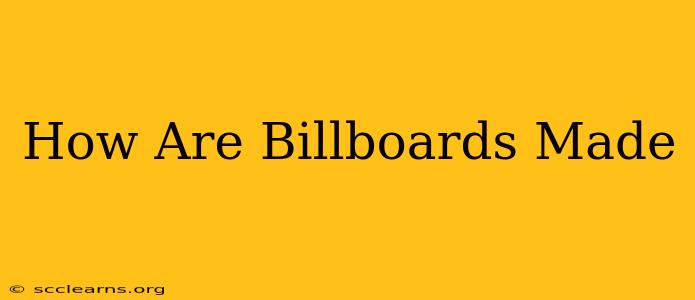Billboards, those massive roadside advertisements, are more than just painted canvases. They're meticulously planned and executed pieces of visual communication, demanding a complex process to bring them to life. This post dives deep into the creation of billboards, from initial concept to final installation.
Phase 1: Concept and Design
The journey begins long before any paint is applied or vinyl is printed. The process starts with a strong concept, reflecting the client's brand and marketing goals.
1. Defining Objectives:
Before a single sketch is made, the advertising agency and client collaboratively define clear objectives. What message needs to be conveyed? What is the target audience? What is the desired call to action? Clear objectives drive the entire design process.
2. Creative Development:
Once objectives are set, the creative team brainstorms and develops several design concepts. This involves:
- Visual brainstorming: Exploring different visual styles, imagery, and typography.
- Keyword research (for digital billboards): Ensuring the text aligns with search intent if the billboard incorporates digital elements.
- Mock-up creation: Developing digital mock-ups to visualize the billboard's appearance in various settings and lighting conditions.
- Client review and approval: Presenting multiple options to the client for feedback and final selection. This crucial step ensures alignment with the client’s vision.
Phase 2: Production and Printing
After the design is finalized, the actual production phase begins. This depends heavily on the type of billboard:
1. Traditional Billboards:
Traditional billboards often utilize large-format printing techniques, and the specific methods depend on the chosen material. Common methods include:
- Vinyl printing: Large-format printers apply vibrant inks directly to durable vinyl, which is then laminated for protection against weather damage. This is a popular choice for its longevity and ease of installation.
- Painting: For some unique designs, skilled artists may hand-paint the billboard directly onto a prepared surface. This is a more labor-intensive and less common method.
2. Digital Billboards:
Digital billboards utilize LED screens, allowing for dynamic content changes. The production process here is different:
- Content creation: Designers create multiple advertisement versions that can be rotated throughout the day to maximize impact.
- Software integration: This involves the setup and configuration of software to manage the content scheduling on the billboard's screen.
Phase 3: Installation and Maintenance
The final stage involves the actual installation of the billboard.
1. Site Preparation:
Before installation, the billboard location needs preparation. This may include structural work, such as erecting supporting structures or ensuring proper grounding.
2. Installation Process:
The billboard panels are carefully affixed to the supporting structure. For digital billboards, this includes connecting the LED screen to the power supply and the content management system. Safety is paramount at this stage.
3. Ongoing Maintenance:
Billboards require regular maintenance to ensure longevity. This might include cleaning, repairing minor damages, or replacing worn-out components. For digital billboards, this also includes software updates and hardware checks.
Maximizing Billboard Effectiveness: SEO Considerations for Digital Billboards
While traditional billboards rely on strong visuals and strategic placement, digital billboards open up opportunities for SEO.
- Location Targeting: Digital billboards can be programmed to display ads based on the geographic location of viewers.
- Data Analytics: Tracking the performance of various ads helps in refining campaigns for maximum impact. Analyze viewer demographics and engagement to optimize your message.
- Keyword Integration (where applicable): If the billboard includes text, use relevant keywords to attract potential customers.
By understanding the entire process, from concept to maintenance, you can appreciate the effort that goes into creating effective billboards and potentially improve your own marketing strategies. Remember, a well-planned and executed billboard is a powerful tool for brand visibility and audience engagement.

